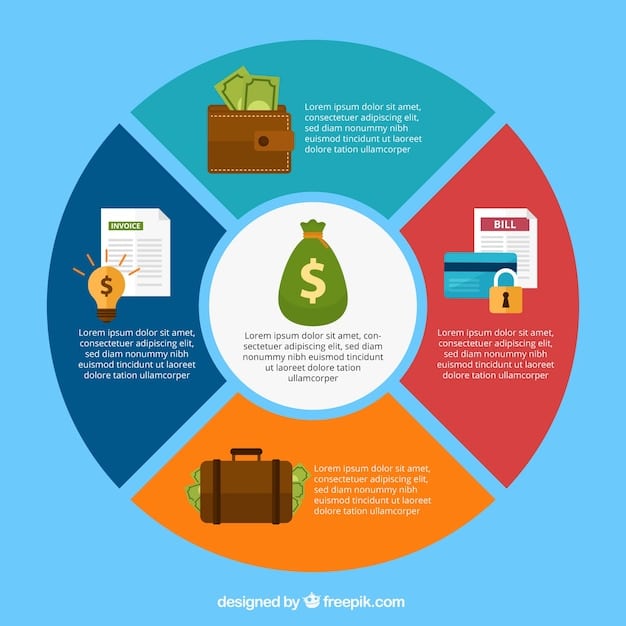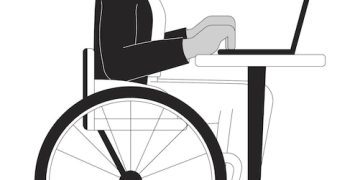Build a $10,000 Emergency Fund in 12 Months: Your Savings Plan

Building a $10,000 emergency fund in 12 months is achievable through a practical savings plan that involves setting clear financial goals, budgeting, automating savings, reducing expenses, and potentially increasing income streams.
Ready to secure your financial future? Discover how to build a $10,000 emergency fund in 12 months with our simple, actionable savings plan, designed to help you achieve financial peace of mind.
Why You Need a $10,000 Emergency Fund
An emergency fund is a financial safety net that can protect you from unexpected expenses such as medical bills, car repairs, or job loss. While the ideal amount varies depending on individual circumstances, a $10,000 emergency fund provides a substantial cushion for most people, covering several months of living expenses.
Having a robust emergency fund minimizes the need to rely on credit cards or loans during crises, preventing debt accumulation and financial stress. It empowers you to handle unforeseen events without derailing your long-term financial goals.
The Cost of Not Having an Emergency Fund
Without an emergency fund, unexpected expenses can lead to a cycle of debt. High-interest credit cards and payday loans often become the only available options, creating a costly burden. Additionally, the stress of financial insecurity can negatively impact mental and physical health.
Assessing Your Current Financial Situation
Before embarking on your savings journey, it’s crucial to assess your current financial standing. This involves evaluating your income, expenses, debts, and existing savings. Understanding your cash flow and net worth provides a baseline for setting realistic savings goals.
- Calculate your monthly income and expenses.
- Determine your net worth by subtracting liabilities from assets.
- Identify areas where you can reduce spending and increase savings.
Building a $10,000 emergency fund is a proactive step toward financial stability. It offers peace of mind and equips you to handle life’s uncertainties without incurring debt or compromising your financial future. By understanding the importance of an emergency fund and assessing your current financial situation, you can begin your journey with a clear plan and achievable goals.

Setting Clear and Achievable Savings Goals
The first step in building your $10,000 emergency fund is setting a clear and achievable savings goal. Breaking down the larger goal into smaller, manageable targets can make the process less daunting and more motivating.
Determine how much you need to save each month to reach your $10,000 goal within 12 months. Regular check-ins and adjustments will keep you on track and ensure you stay motivated along the way.
Calculating Your Monthly Savings Target
To calculate your monthly savings target, divide your total goal ($10,000) by the number of months you have to achieve it (12). This simple calculation provides a clear monthly savings goal that you can aim for.
For instance, $10,000 divided by 12 months equals approximately $833.33 per month. This is how much you need to save each month to reach your $10,000 goal in 12 months.
Breaking Down Your Savings into Weekly Targets
Further breaking down your monthly savings target into weekly targets can make saving even more manageable. Divide your monthly target by four to determine how much you need to save each week.
- Calculate your monthly savings goal.
- Divide the monthly goal by four to get your weekly target.
- Track your progress to stay motivated.
Setting clear and achievable savings goals is crucial for success. By knowing exactly how much you need to save each month and week, you can stay focused and motivated throughout your savings journey. Consistent monitoring and adjustments will help you reach your $10,000 emergency fund goal in 12 months.
Creating a Detailed Budget
Creating a detailed budget is essential for identifying where your money is going and where you can make adjustments to save more effectively. A budget helps you track your income and expenses, highlighting areas where you can cut back and redirect funds to your emergency fund.
By meticulously tracking your spending, you can pinpoint unnecessary expenses and prioritize saving. A well-structured budget is the cornerstone of a successful savings plan.
Tracking Your Income and Expenses
Start by listing all sources of income, including salary, freelance work, and investments. Then, track all your expenses, categorizing them into fixed costs (rent, utilities) and variable costs (groceries, entertainment).
Identifying Areas to Cut Back
Once you have a clear picture of your spending habits, identify areas where you can reduce expenses. Consider cutting back on non-essential items like dining out, subscriptions, and entertainment. Even small reductions can add up over time.

Utilizing Budgeting Tools and Apps
There are numerous budgeting tools and apps available to help you track your spending and manage your finances. These tools can automate the budgeting process, provide insights into your spending habits, and help you stay on track.
- Track income and expenses.
- Identify areas for savings.
- Use budgeting apps for easy management.
A detailed budget provides a roadmap for your savings journey, guiding you toward your $10,000 emergency fund goal. By meticulously tracking your income and expenses, identifying areas to cut back, and utilizing budgeting tools, you can ensure you’re maximizing your savings potential.
Automating Your Savings
Automating your savings is a powerful strategy for consistent progress toward your emergency fund. By setting up automatic transfers from your checking account to a savings account, you remove the temptation to spend those funds and ensure regular contributions to your savings goal.
Automated savings simplifies the process and makes it a seamless part of your financial routine. It’s an effective way to build your emergency fund without conscious effort.
Setting Up Automatic Transfers
Most banks offer the option to set up automatic transfers between accounts. Choose a savings account specifically for your emergency fund and schedule regular transfers from your checking account.
Choosing the Right Savings Account
Select a savings account that offers a competitive interest rate to maximize your returns. High-yield savings accounts or money market accounts can provide higher interest rates than traditional savings accounts.
Adjusting Your Savings Rate Over Time
As your income increases or your expenses decrease, consider adjusting your automated savings rate to accelerate your progress. Even small adjustments can significantly impact your savings timeline.
- Set up automated transfers.
- Choose a high-yield savings account.
- Adjust your savings rate for faster progress.
Automating your savings is a game-changer for building your emergency fund. By setting up automatic transfers, choosing the right savings account, and adjusting your savings rate over time, you can ensure consistent, effortless progress toward your $10,000 goal.
Reducing Expenses and Finding Extra Money
Reducing expenses is a key component of building a $10,000 emergency fund. Identifying areas where you can cut back on spending frees up more funds to allocate to your savings goal. Simple lifestyle changes and creative cost-cutting measures can significantly increase your savings potential.
Finding extra money through side hustles or selling unwanted items can provide an additional boost to your savings efforts.
Negotiating Bills and Subscriptions
Contact your service providers to negotiate lower rates on bills such as internet, cable, and insurance. Review your subscriptions and cancel any that you no longer use or need.
Cutting Back on Discretionary Spending
Identify areas of discretionary spending that can be reduced or eliminated. This may include dining out, entertainment, and impulse purchases. Prioritize essential spending and cut back on non-essential items.
Exploring Side Hustles and Income Opportunities
Consider taking on a side hustle to supplement your income and accelerate your savings. Explore opportunities such as freelancing, driving for ride-sharing services, or participating in online surveys.
- Negotiate bills and subscriptions.
- Cut back on discretionary spending.
- Explore side hustles for extra income.
Reducing expenses and finding extra money is a powerful way to boost your savings. By negotiating bills, cutting back on discretionary spending, and exploring additional income opportunities, you can accelerate your progress toward your $10,000 emergency fund goal.
Staying Motivated and Tracking Progress
Staying motivated is crucial for the long-term success of your savings plan. Building a $10,000 emergency fund takes time and commitment, so it’s important to implement strategies to keep yourself engaged and focused. Tracking your progress and celebrating milestones can provide the motivation you need to reach your goal.
Visualizing your progress and acknowledging your achievements will help you stay on track and maintain your momentum.
Visualizing Your Savings Progress
Create a visual representation of your savings progress, such as a chart or graph, to track your growth. Seeing your savings increase over time can be highly motivating.
Celebrating Milestones and Achievements
Acknowledge and celebrate your milestones along the way. Treat yourself to small rewards when you reach specific savings targets to reinforce positive habits.
Seeking Support and Accountability
Share your savings goals with friends or family members and ask for their support and accountability. Having someone to encourage you and hold you accountable can increase your chances of success.
- Visualize your savings progress.
- Celebrate milestones and achievements.
- Seek support and accountability.
Staying motivated and tracking progress is essential for achieving your $10,000 emergency fund goal. By visualizing your savings, celebrating milestones, and seeking support, you can maintain your focus and commitment throughout your savings journey, turning financial aspirations into reality.
| Key Point | Brief Description |
|---|---|
| 🎯 Set Clear Goals | Define monthly/weekly savings targets. |
| 💰 Create a Budget | Track income and expenses, identify cuts. |
| ⚙️ Automate Savings | Set up recurring transfers to a savings account. |
| 💸 Reduce Expenses | Negotiate bills, cut discretionary spending. |
FAQ Section
▼
An emergency fund is a savings account specifically for unexpected expenses like medical bills or car repairs. It prevents relying on debt and provides financial security.
▼
To reach a $10,000 goal in 12 months, you should aim to save approximately $833.33 per month. Breaking it into weekly targets can also help.
▼
Consider negotiating bills, cutting back on dining out, cancelling unused subscriptions, and reducing discretionary spending such as entertainment and impulse purchases.
▼
Opt for a high-yield savings account or a money market account to maximize interest earned. Ensure the account is easily accessible in case of an emergency.
▼
Visualize your progress, celebrate milestones, seek support from friends or family, and remember the security a fully funded emergency fund provides. A visual tracker also helps.
Conclusion
Building a $10,000 emergency fund in 12 months requires dedication, discipline, and a strategic approach. By setting clear savings goals, creating a detailed budget, automating savings, reducing expenses, and staying motivated, you can achieve financial security and peace of mind. Start today, and you’ll be well on your way to securing your financial future.





